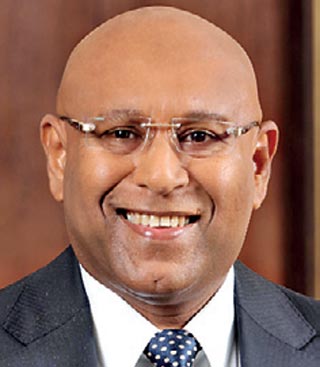Friday Dec 05, 2025
Friday Dec 05, 2025
Tuesday, 15 November 2022 00:57 - - {{hitsCtrl.values.hits}}
 |
| Chairman Sriyan Cooray |
 |
| Director and CEO Dimantha Seneviratne
|
National Development Bank PLC yesterday announced moderate performance in the first nine months of 2022 but stressed it navigated challenges with agility and stability.
It said financial performance continued to be challenged by the prevailing macro-economic conditions, adversely impacting profitability for a continued third quarter, as seen across the entire banking industry. Director and CEO Dimantha Seneviratne said: “We are navigating through a set of unique challenges hitherto not experienced by Sri Lanka or the banking sector. In such context we are exercising maximum diligence, with high priority on prudent risk management strategies, concerted support to customers in need and preserving shareholder value.
“We also remain strongly aligned to the Government of Sri Lanka’s mission in expeditiously reviving the national economy, with the support of the International Monetary Fund.”
The nine months period under review posted a pre-tax profit of Rs. 790 million, a 91% reduction over the comparative period of the nine months ended 30 September 2021.
Whilst the top line continued to grow, the profit deceleration reported since the beginning of 2022 is predominantly attributable to the increased impairment charges booked in both the loan book and investment portfolio, warranted by macro-economic conditions.
Despite this, performance of core banking operations was noteworthy, where net interest income grew by 39% to Rs. 22.2 billion. With the upward movement in interest rates in the market, interest income as well as interest expenses increased, reflecting timely re-pricing of the asset book, and mobilization of deposits respectively. Net interest margin closed in at 3.78% compared to 3.25% of 2021, benefitting from strategic deployment of funds.
Net fee and commission income also increased by 10% to Rs. 4.4 billion, mainly driven by trade business, retail banking operations and digital banking initiatives. Other non-fund based income totalled Rs. 4.9 billion, predominantly benefitting from the revaluation gains on the bank’s foreign currency denominated reserves, due to the sharp depreciation of the rupee against the dollar.
The bank accounted Rs. 22.2 billion as impairment charges for the period under review, a 234% increase over the comparative period. The greater portion of impairment charges continued to comprise provisions made for foreign currency denominated government securities, factoring in the revisions to the sovereign rating of the country earlier this year on account of the country’s debt restructuring measures and the impact arising from rupee depreciation. Impairment provisions for loans also increased during the period, to factor in macroeconomic impact on loan book quality.
The resultant ratios indicating impairment levels were; Impaired Loans (Stage 3) Ratio and Impairment (Stage 3) to Stage 3 Loans Ratio were 5.75% (2021: 4.55%) and 34.66% (2021: 32.81%) respectively.
The bank’s tight grip on costs helped manage the increase in expenses by only 10% to Rs. 8.5 billion, amidst high inflation. Cost to income ratio continued below the 30% mark, benefitted by both revenue enhancements and cost curtailments, the latter attributable to automation of processes and greater skewing to digital modes in delivering banking services to customers. Taxes netted Rs. 228 million, with a FSVAT of Rs. 762 million at 18%, compared to 15% in the comparative quarter of 2021.
The Bank posted total assets of Rs. 819 billion by the end of the review period, whilst the same at the group level was Rs. 825 billion, a 16% increase over end 2021 position (YTD growth). Within total assets, Gross loans to customers closed in at Rs. 600 billion, a YTD increase of 14%, attributable to both the impact of rupee depreciation and moderate growth stemming from all business segments.
On Balance Sheet funding, customer deposits were Rs. 649 billion, a YTD increase of 18%, again attributable to the dual factors of inflationary effects of the rupee depreciation against the dollar, and also concerted deposit mobilization at granular level within the retail segment as well as across business segments.
Return on average equity and Earnings per share were 1.24% and Rs. 1.97 respectively. Pre-tax Return on Average Assets was 0.14%. Regulatory ratios of Liquidity Coverage Ratio (Rupee), Liquidity Coverage Ratio (All Currency) and Net stable Funding Ratio stood well above the regulatory minimum requirement of 90% at 208.00%, 158.02% and 123.19% respectively.
Tier I and Total Capital Adequacy ratios as of end September 2022 were 9.42% and 13.60%, ahead of the regulatory minimum levels of 8.5% and 12.5% respectively, before considering capital relief measures on capital conservation buffers mandated by the CBSL recently.
The bank continued to maintain high liquidity standards as denoted in the Statutory Liquid Assets Ratio of Domestic Banking Unit and Off-Shore Banking Unit at 22.80% and 25.40% respectively, well above the regulatory minimum requirement of 20%. Net asset value per share as at end Q3 2022 was Rs. 162.17 (2021: Rs. 165.02).
NDB said given subdued economic activity, business growth in the banking industry for the remainder of the year will be moderate. Reduced debt serviceability of customers and potential restructuring anticipated on exposure to Government’s international sovereign bonds will also exert pressure on industry-wide capital adequacy level, which will prompt further calibration to banks’ growth targets.
NDB will follow suite in this regard, where growth will be cautious and calculated to balance off adequate capital levels. The bank’s other strategic priorities, such as innovations on digital front, customer-centricity, empowering the women’s market segment, internal process streamlining and automations, staff development, etc., will continue unabated, affording NDB a strong platform to launch ahead, once the country’s economic conditions improve.